Memories of Panjim
Olga is delighted when she learns I was recently in Goa. “I’m from Mumbai,” she says, “but a Goan Catholic.” I meet her by chance at a Hong Kong restaurant, and before it gets too busy with patrons, I declare my adoration for the food of her home state. There are two things I regret not doing in Panjim, Goa’s laid-back state capital: the first is that I didn’t stay longer, and the second, that I never joined a Goan cooking class.
But here I am, getting a primer on my favourite Goan dish, xacuti, in my hometown. “It uses fried coconut,” Olga says. “I sometimes make xacuti at home, but it isn’t the same. It tastes different in Goa because they take coconuts fresh from the tree and shred the meat.” With those words, I instantly recall the slivers of grated coconut that gave a crunch to the smoky richness of xacuti. Olga tells me the dish is spiced with cinnamon and cloves, and I begin to realise why it reminded me so much of Indonesian cooking.
When I think of Goan cuisine, my mind drifts back to Fontainhas, Panjim’s old Latin quarter. William Dalrymple, that prolific writer on Indian history, calls it a “small chunk of Portugal washed up on the shores of the Indian Ocean”. It’s not hard to see why. Fontainhas’ colonial houses are painted the colours of tangerine, guava and pomegranate. This sleepy neighbourhood is buffered from the commercial core of Panjim by a verdant hillock, and the 21st-century visitor will find it dotted with heritage guesthouses.
The balconied Hospedaria Abrigo de Botelho commands one section of Rua de Natal, ‘Christmas Street’. More than 150 years old, the house has been lovingly restored, its multi-paned doors and windows framed by spotless white on a sky blue background. What was intended as a family home has been turned into an intimate B&B, and Bama and I meet the jovial Goan owner, Roy Botelho, soon after checking in. With a name like that, I’m curious to know if he speaks Portuguese. “It’s the language I use at home,” Roy tells us. “I speak it with my parents.”
The Portuguese have been gone for more than half a century – expelled when India annexed the last of their South Asian territories – but a certain nostalgia for that era persists among older Goans. More broadly, the concerns of a modern-day Goan mirror those of my native Hong Kong. Wealthy outside investors have pushed housing prices beyond the reach of most residents, a slew of expensive shops cater to tourists instead of locals, and with the influx of arrivals from other Indian states, Goans fear an erosion of their hybrid, east-meets-west culture. Roy tells us the carnival celebrated in today’s Goa is incomparable to the unorchestrated madness he remembers from his youth.
But some things remain. For a taste of genuine Goan cuisine, we are directed to Viva Panjim, an intimate restaurant in Fontainhas where the recipes have been passed down from the proprietor’s own grandmother. I’m surprised to find out that fiery vindalho, which originated in Goa, is usually eaten with pork (we opt for fish). With its telltale notes of vinegar and a complex heat that builds over time, the original vindalho is a far cry from the Anglo-Indian version that has been popularised around the world.
If vindalho is the attention-grabbing star of the show, then shrimp and okra caldinha is a mellow, unassuming figure in the background. A comforting blend of coconut milk, turmeric and other spices, caldinha strikes me because of its familiarity – it is almost identical to the ‘Portuguese sauce’ found in Hong Kong and Macau.
But xacuti is an even bigger revelation. Bama and I had ordered it on our first night in Panjim, when we went for dinner at a no-frills restaurant called George. The place fronted the tree-lined boulevard below Immaculate Conception Church, which rose above a crisscrossing stairway crowned by a statue of the Virgin Mary. In the relative darkness of the restaurant, our first xacuti looked underwhelming – chunks of meat smothered in a lumpy brown sauce. But one spoonful convinced us otherwise, as an unexpected riot of textures and flavours tickled our palates. The xacuti at Viva Panjim would prove even better.
Back at Roy’s Hospedaria, we learn that xacuti is typically cooked with beef or chicken, and its complexity comes from a blend of 14 different spices. Later research reveals just how elaborate it truly is – the dish requires not one masala (spice paste), but three; one for marinating the meat, and two others for the actual cooking. Meeting Olga, I’m reminded that it is the one recipe I should have taken home from Panjim. ◊

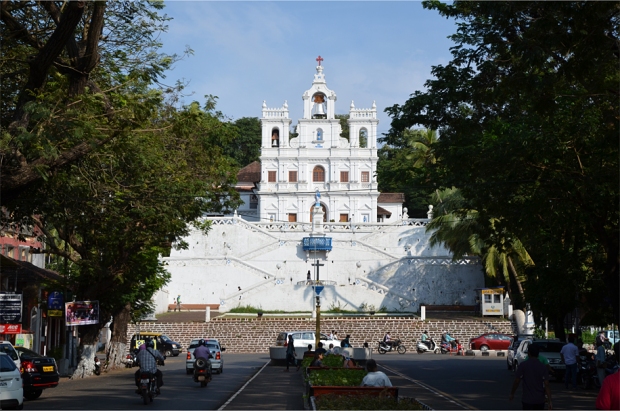

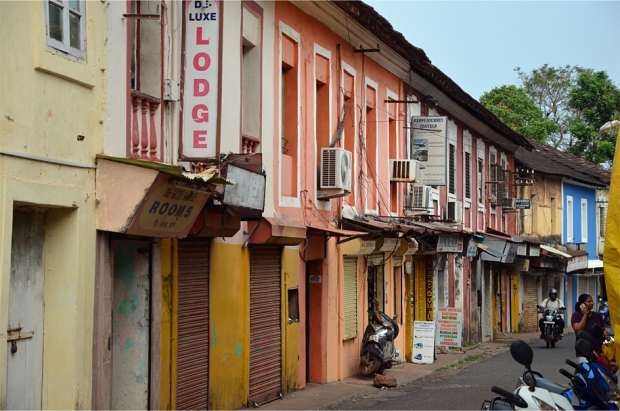

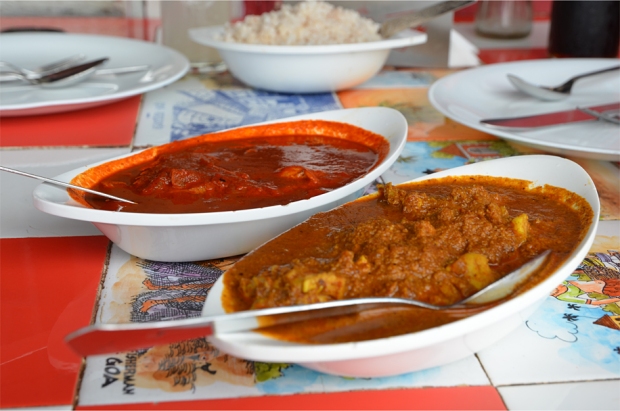


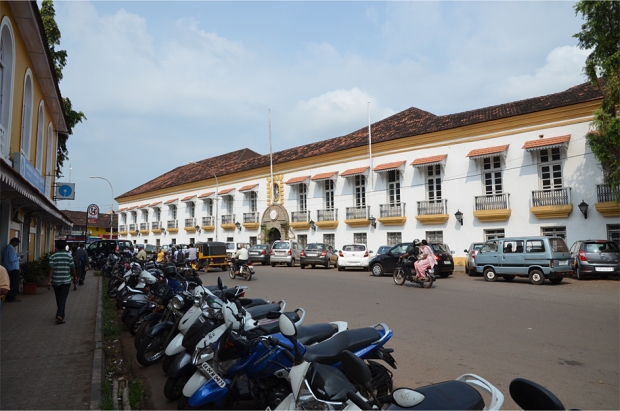


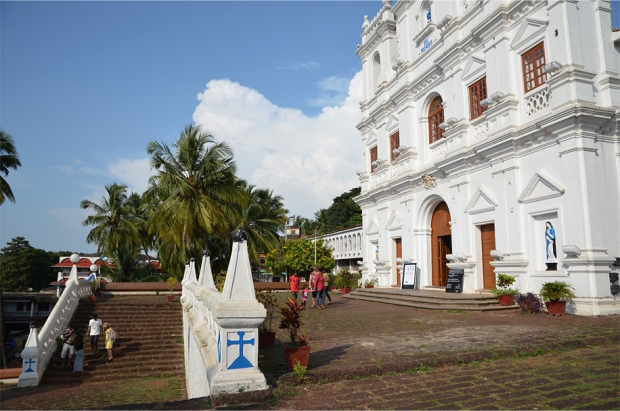
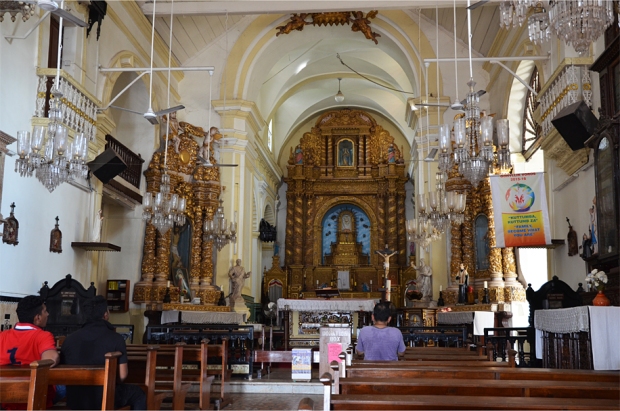





I loved Goa…and the food.
It was one of my favourite parts of India. Three days was far too short… I should really have stayed at least a week!
Great Content!
Thanks!
It’s hard to believe that India has so European face like this. The foods are even more interesting, since the appearance looks like typical Indonesian/Asian food but the name are influenced by Portuguese. Menarik. Jadi pengen jalan ke Goa 🙂
Well, after more than 400 years of being there the Portuguese really left their mark! Some of the old villas and houses have been demolished, but many still remain standing. I am sure you will enjoy the food as much as Bama and I did. Mudah-mudahan bisa kesana suatu hari nanti. 🙂
Amiiiin, mudah-mudahan James 🙂
I love the special vibe of Goa too. AND the food. I agree with Olga about coconuts tasting better there. In fact they taste better all along the West coast. Must be something to do with the red soil. In the early days, I had my mom send me sackfuls from Mangalore! Beautiful post and images James. Hope all’s well with you.
Thank you, Madhu. Just imagining those precious sacks being transported up to the Nilgiris makes me smile. Given my love of coconut, I wonder if that explains my preference for West coast Indian food – including the Mangalorean curry you cooked us in Chennai!
Ha, then it must be my special touch, for the coconuts were local and not the best 🙂
Beautiful post. You gave me a real sense of the place and its cuisine.
Much appreciated, Caroline. I hope you get to visit Goa in the near future!
Two things I really enjoyed in Goa: Velha Goa and the food (remember that Dutch lady who said we were strange for not going to the beach?) 😀 I agree that we should have spent a few more days in Goa to take a cooking class and sample more local dishes. Together with Keralan food, Portuguese-influenced Goan dishes were some of my favorites during our month-long trip across southern India.
Well, there’s always a next time, Bama. 😀 I would love to go back and spend a week learning more about Goan food and the culture it represents. Although our time there was short, it was the perfect way to kick off that month in India.
Hey! You just brought back tons of memories for me as well! I am from Kerala so the kind of food we cook is almost the same! Missing it all in U.S though! Hope you are doing well otherwise!
Thanks! It definitely feels like north Indian food gets most of the limelight overseas. I have to say that Keralan is my favourite regional cuisine in India – Goan comes a close second!
I love your post because I went to Goa looking for someone who spoke portuguese and I couldnt find anybody. I am from the north of Spain, Galicia , a place next to Portugal where we speak galego a language very similar to Portuguese. So it would be great to talk with some indian in portuguese! I loved Goa too, this is very different to the rest of India but I was very surprised when I arrived to Kerala…The most beautiful nature I have ever seen!! Congrats!! Nice post!! I will come back to Goa!!
It is fascinating to think that Galego and Portuguese came from the same root. Galicia was one region I didn’t get to visit when I lived in Spain some years ago. My mother has been asking when I will walk the Camino de Santiago with her! When you return to Goa, I think you should have no problem finding a Portuguese speaker in Fontainhas. Roy and his hospedaria would be a good place to start!
I will try it, James! 🙂 And walk the camino de santiago 🙂 it is the best experience that you can imagine! I have walked twice and I will repit it 😉
Wow Rocío, it sounds like I should really start planning a trip along the Camino – hopefully it will happen in the next few years. I can’t wait to visit Galicia when I do! 🙂
I am a Goan, one of those who speaks Portuguese reasonably fluently. Once I was at a British pub, chatting to a Brazilian girl of Japanese descent, when I heard a remark made in French, “Here is an Indian talking to a Japanese in Portuguese, in an English pub”.
By the way, just to correct an incorrectly spelled word by most anglophones – it is VINDALHO, spelling of which was modified by people to suit the unfamiliar “lho” unpronounceable by the English-educated folk. Pronunciation of surnames such as Carvalho and Noronha are similarly garbled by people from outside Goa to “-loo” and “-nya” respectively. Great article, though.
Hello Antonio, obrigado for the feedback. It’s not often that I receive comments on older posts, especially from someone with deep personal connections to the places featured in them. Noted on the correct spelling of “vindalho” – I have just fixed all instances in the text and will bear that in mind the next time I visit your beautiful home state. Not sure why the pronunciation of “lho” is seen as a challenge but I suppose many anglophones are not adept at learning other languages.
What a wonderful surprise, Antonio! I am from Galicia (in the North of Spain) and our language, Galician, was once the same language as Portuguese, so I was subconsciously looking for traces of Portuguese and in addition to some surnames, names of restaurants or hotels… some customs like fishing and eating fish… I barely found people who could speak to me in Portuguese. So it is a very nice surprise to know about you! 🙂
Thank you very much for your coment! You are wellcome! 😀
Its been a while since I was in Goa so I loved reading your post. It brought back many good memories. Thanks for sharing.
You’re welcome. I’m glad this took you on a little trip down memory lane.
GREAT post on Goa, James. Love all your photos as usual, especially the blue house. And your content is very striking in this post, you can almost feel a love of the place…with sentences like this: “If vindaloo is the attention-grabbing star of the show, then shrimp and okra caldinha is a mellow, unassuming figure in the background.” I’ve been to Goa a number of times, and I never even considered spending time in Panjim, it was a place–a city!–I simply wanted to avoid. But you’ve put a whole different spin on the place. And when I return, I will spend time there. So thanks for that!
You are too kind, Badfish! Bama and I were sitting next to a lovely Dutch woman on the flight in, and it was her annual visit to Goa for escaping the European winter. She joked that we were strange fellows to go straight to Panjim and eschew the beaches… but we’d come precisely for the food, the culture and colonial architecture. Panjim was a recommendation from a Goan we’d met at a cooking class in Penang – without that tip we might never have stayed there!
James what a beautifully written and delicious post. I found myself salivating at your eloquent descriptions of tastes. Also I did not know about the Portuguese influence. Beautiful photos to go along with this stellar post.
Thanks so much, Sue. Goa was a Portuguese colony for over 400 years – I guess that has allowed the area to develop its own unique identity and cuisine.
Making me hungry here!! However the advantage of living in Mumbai is we DO get some pretty decent Goan dishes here too. Just not quite the same as having in Panji! 🙂
Lucky you! Goan food in Hong Kong is limited to vindaloo and prawn curry on menus that tend to favour north Indian dishes… so I doubt that they are truly authentic.
Heck I don’t even need to go to a restaurant, can pop over to a friends home. Can you say spoilt?? 😉
I can say jealous!! 😉
Goa has been on my radar for a while because we have friends from there, but your post is a good poke to keep this destination strongly in mind! I love the colorful colonial architecture and the food looks amazing.
Lex, you should definitely go! It was easily one of my favourite parts of India – I loved the laid-back feel and the strong Portuguese influence. Most people visit for the beaches but Goa has so much more than that.